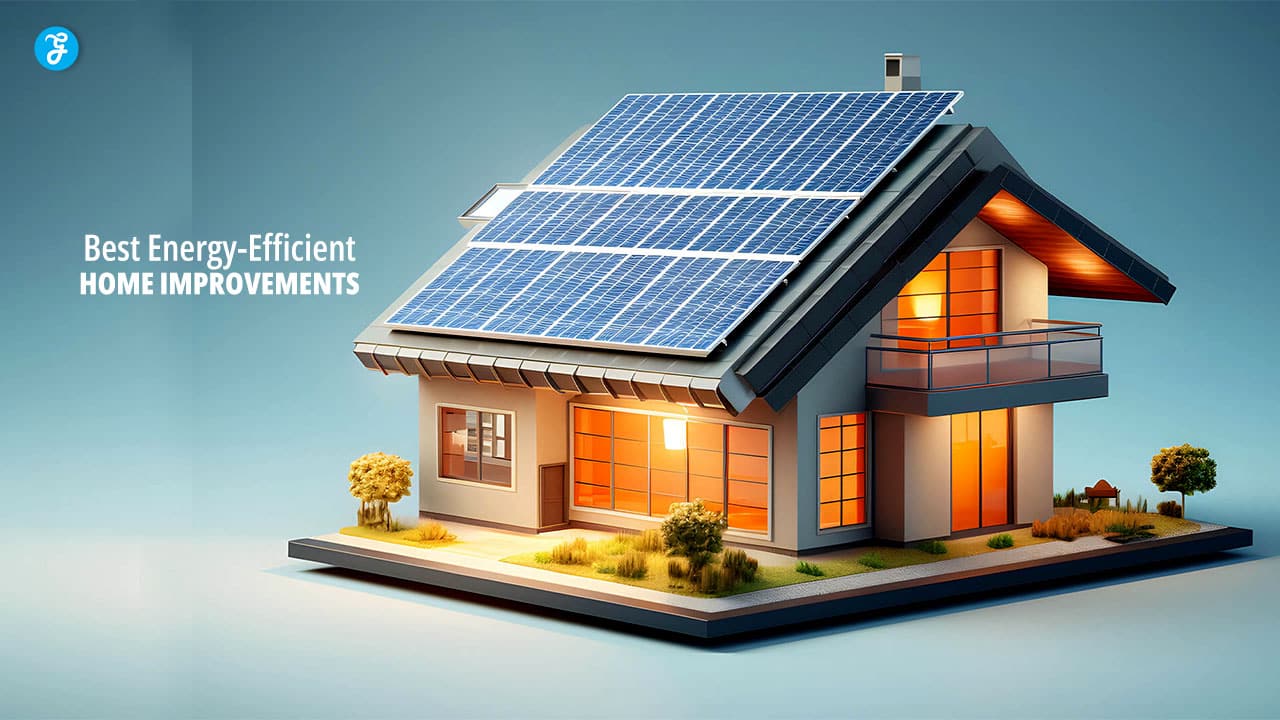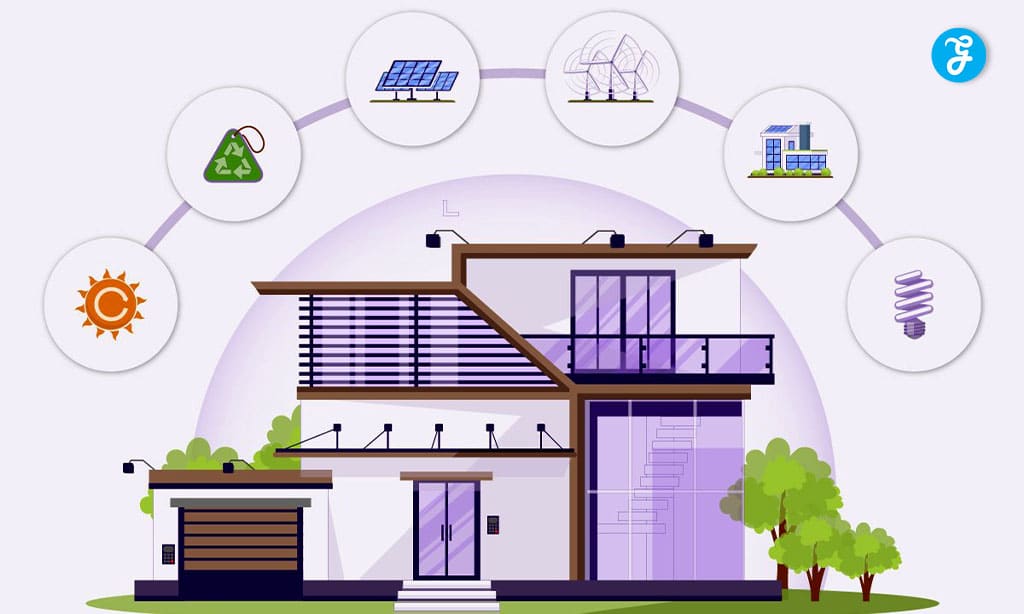Energy expenses form a substantial portion of household budgets across the United States. The average American family spends more than $2,000 annually on energy bills, with heating, cooling, and water heating accounting for over half of this amount.
By implementing energy efficient home improvements, homeowners can slash these costs while simultaneously enhancing their living environment and reducing their carbon footprint.
Here’s a breakdown for you on how to make energy efficient home improvements that save you money.
11 Energy Efficient Home Improvements [Low Budget]
In an era of rising energy costs and growing environmental concerns, making your home more energy-efficient isn’t just a trend; it’s a smart financial decision. From quick, low-cost fixes to more substantial upgrades, we’ll explore options suitable for every budget type for maximum energy-efficiency at home. Here’s how you can opt for Energy-Efficient home improvements within your budget.
1. Seal Air Leaks
One of the most cost-effective ways to boost your home’s energy efficiency is to seal air leaks. These seemingly insignificant gaps and cracks around windows, doors, and other openings can lead to significant energy waste.
Why it matters: The Department of Energy estimates that sealing air leaks can reduce heating and cooling costs by an average of 15%. In a typical single-family home, this could translate to annual savings of $200 to $400.
How to do it:
- Conduct a thorough inspection of your home’s exterior and interior. Pay close attention to areas where different building materials meet, such as where siding intersects with chimneys or where the foundation meets the walls.
- Use a stick of incense or a damp hand to detect air movement around potential leak areas.
- For small gaps (1/4 inch or less), use caulk. Silicone caulk is best for exterior use as it’s waterproof and flexible.
- For larger gaps, use expanding foam sealant. Be cautious, as this foam expands significantly as it dries.
- Install weatherstripping around movable components like doors and windows. Choose appropriate materials based on the amount of friction the area experiences.
- Don’t overlook less obvious areas like electrical outlets on exterior walls. Install foam gaskets behind outlet covers to prevent air leakage.
- Check your attic hatch or pull-down stairs. These often-overlooked areas can be a significant source of heat loss.
Cost: $200 to $500 for materials, depending on the size of your home and the extent of air leaks.
Potential savings: 15% on heating and cooling costs, which could amount to $200 to $400 annually for the average household.
2. Upgrade to LED Lighting
Switching from traditional incandescent bulbs to LED lighting is one of the easiest and most impactful energy-saving measures you can take.
Why it matters: LED bulbs use about 75% less energy than incandescent bulbs and last 25 times longer. This means lower electricity bills and fewer bulb replacements.
How to do it:
- Start by replacing the bulbs in your most frequently used fixtures. These will yield the quickest payback.
- Pay attention to the color temperature when choosing LED bulbs. Warm white (2700K-3000K) is similar to traditional incandescent light, while cool white (5000K-6500K) provides a brighter, more daylight-like illumination.
- Look for ENERGY STAR certified bulbs. These have received independent certification that they adhere to strict energy efficiency standards set by the EPA and DOE.
- Consider smart LED bulbs that can be controlled via smartphone apps or voice assistants. While more expensive upfront, these can lead to additional energy savings through features like scheduling and remote control.
- Don’t forget about outdoor lighting. LED bulbs work well in cold temperatures, making them ideal for exterior fixtures.
Cost: $40 to $150 to replace 20 of the most used bulbs in a home.
Potential savings: The average household can save about $225 in energy costs per year by replacing 20 incandescent bulbs with LED alternatives.
3. Install a Programmable or Smart Thermostat
Heating and cooling account for nearly half of the average home’s energy consumption. A programmable or smart thermostat can help you manage this energy use more efficiently.
Why it matters: By automatically adjusting your home’s temperature based on your schedule, these thermostats can significantly reduce energy waste without sacrificing comfort.
How to do it:
- Choose a thermostat that’s compatible with your HVAC system. Some systems, particularly older ones, may not work with certain smart thermostats.
- For a programmable thermostat, set it to lower the temperature by 7-10 degrees for 8 hours a day (while you’re asleep or away) in winter, and raise it by a similar amount in summer.
- If opting for a smart thermostat, take advantage of features like geofencing, which uses your smartphone’s location to adjust the temperature automatically when you leave or return home.
- Place the thermostat away from heating and cooling vents, doors, windows, and direct sunlight to ensure accurate temperature readings.
- Take time to learn and use all the features of your new thermostat. Many smart thermostats offer energy reports and tips for additional savings.
Cost: $30 to $300, depending on the model and features.
Potential savings: According to the Department of Energy, you can save up to 10% a year on your heating and cooling costs by turning your thermostat back 7°-10°F for 8 hours a day. For the average household, this could mean annual savings of $180.
4. Use Power Strips
Many electronic devices continue to draw power even when they’re turned off, a phenomenon known as “vampire” or standby power. This can account for 5-10% of residential electricity use.
Why it matters: By using power strips, particularly advanced or “smart” models, you can completely cut off power to devices when they’re not in use, eliminating this wasteful standby power consumption.
How to do it:
- Identify areas in your home with clusters of electronics, such as entertainment centers or home office setups.
- Use smart power strips that can detect when a device is in standby mode and cut power to it.
- For simpler setups, use a basic power strip with an easily accessible on/off switch.
- Group related equipment together. For example, put your TV, gaming console, and DVD player on one strip.
- Label your power strips so you can easily identify which devices are connected to each.
- Consider timer-equipped power strips for devices that only need power at certain times of day.
Cost: $10 to $40 per power strip, depending on features.
Potential savings: Eliminating standby power can save the average household $100 to $200 per year on electricity bills.
5. Add Insulation
Proper insulation is crucial for maintaining a comfortable temperature in your home and reducing energy waste. Many homes, especially older ones, are under-insulated by modern standards.
Why it matters: Adequate insulation can reduce heating and cooling costs by up to 15%, according to the EPA. It also helps maintain a more consistent temperature throughout your home, increasing overall comfort.
How to do it:
- Start with the attic, as it’s often the easiest place to add insulation and can have the biggest impact.
- Determine your current insulation levels and compare them to recommended R-values for your climate zone. The R-value measures insulation’s ability to resist heat flow.
- Choose the right type of insulation. Options include fiberglass batts, blown-in cellulose, spray foam, and rigid foam boards. Each has its pros and cons in terms of cost, effectiveness, and ease of installation.
- For DIY installation, batts or rolls are typically easiest to handle. Blown-in insulation requires special equipment but can be more effective at filling irregular spaces.
- Don’t forget about other areas like walls, floors over unheated spaces, and crawl spaces.
- Ensure proper ventilation, especially in attics, to prevent moisture buildup.
- Consider hiring a professional for a comprehensive home energy audit to identify all areas that need attention.
Cost: $1,500 to $2,500 for professional attic insulation in an average-sized home. DIY costs can be significantly lower.
Potential savings: Up to 15% on heating and cooling costs, or an average of 11% on total energy costs. This could amount to $200 to $400 annually for the average household.
6. Upgrade to ENERGY STAR Appliances
ENERGY STAR certified appliances use advanced technologies to reduce energy consumption without sacrificing performance. They can lead to significant energy savings over the life of the appliance.
Why it matters: Major appliances account for a large portion of home energy use. Upgrading to more efficient models can result in substantial long-term savings.
How to do it:
- Prioritize replacing your oldest and most frequently used appliances first. Refrigerators, washing machines, and dishwashers are often good starting points.
- Look for the ENERGY STAR label when shopping for new appliances. This certification ensures the product meets strict energy efficiency guidelines set by the EPA and DOE.
- Consider the EnergyGuide label, which provides estimated annual energy consumption and operating costs. This can help you compare different models.
- Don’t just focus on the purchase price. Factor in the long-term energy savings when making your decision.
- Properly size your new appliances. An oversized air conditioner or water heater, for example, will waste energy.
- Recycle your old appliances responsibly. Many retailers offer recycling services when you purchase a new appliance.
Cost: Varies widely by appliance. ENERGY STAR models may cost 10-20% more than standard models upfront.
Potential savings: Varies by appliance, but can be substantial:
- ENERGY STAR certified refrigerators use about 15% less energy than non-certified models, saving about $80 over its lifetime.
- ENERGY STAR washing machines use about 25% less energy and 33% less water than regular washers, saving about $370 over their lifetime.
- ENERGY STAR dishwashers are 12% more energy efficient and 30% more water efficient than standard models, saving an average of $35 per year on utility bills.
7. Install Low-Flow Water Fixtures
Low-flow fixtures can significantly reduce your water usage, saving both water and the energy used to heat it. This is especially impactful considering that water heating is typically the second-largest energy expense in homes.
Why it matters: According to the EPA, the average family can save 2,700 gallons of water per year by installing low-flow fixtures. This not only reduces water bills but also cuts energy costs associated with water heating.
How to do it:
- Replace old showerheads with WaterSense labeled models. These use no more than 2 gallons per minute, compared to the standard 2.5 gallons.
- Install faucet aerators in the kitchen and bathrooms. These simple devices mix air with water to maintain good water pressure while reducing flow.
- Consider dual-flush toilets or add a dual-flush converter to existing toilets. These provide different flush volumes for liquid and solid waste.
- Look for WaterSense labeled products. These are independently certified to use at least 20% less water than standard models.
- Don’t forget about outdoor water use. Consider installing a rain barrel or choosing drought-resistant landscaping to reduce water needs.
Cost: $10 to $20 for a low-flow showerhead or faucet aerator. $100 to $300 for a new low-flow toilet.
Potential savings: Up to $380 per year on water and energy bills for a typical family, according to the EPA.
8. Upgrade to Double-Pane Windows
If your home has old, single-pane windows, upgrading to double-pane windows can make a significant difference in your energy bills and home comfort.
Why it matters: Windows can be a major source of heat loss in winter and heat gain in summer. Double-pane windows provide better insulation, reducing the workload on your heating and cooling systems.
How to do it:
- Hire a professional to ensure proper installation. Improper installation can negate much of the energy-saving benefits.
- Look for ENERGY STAR certified windows. These are independently certified to meet strict energy efficiency guidelines.
- Consider low-E coatings for additional energy savings. These coatings reflect infrared light, keeping heat inside in winter and outside in summer.
- Choose windows with low U-factor and Solar Heat Gain Coefficient (SHGC) ratings for maximum energy efficiency.
- Don’t neglect proper weatherstripping and caulking around the new windows to prevent air leaks.
- If full window replacement isn’t in your budget, consider less expensive options like adding storm windows or window films to existing windows.
Cost: $300 to $1,000 per window for professional installation, depending on size and type.
Potential savings: $126 to $465 per year when replacing single-pane windows in a typical home, according to ENERGY STAR.
9. Install a High-Efficiency HVAC System
Heating and cooling account for nearly half of the average home’s energy use. A high-efficiency system can significantly reduce this energy consumption.
Why it matters: Modern, high-efficiency HVAC systems can be 20-30% more efficient than older models. This can lead to substantial energy savings over the life of the system.
How to do it:
- Have a professional assess your home’s heating and cooling needs. Proper sizing is crucial for maximum efficiency.
- Choose an ENERGY STAR certified system. These are independently certified to be more efficient than standard models.
- Consider a heat pump system, which can provide both heating and cooling. In moderate climates, these can be very energy efficient.
- Ensure proper installation. Even the most efficient system will underperform if not installed correctly.
- Don’t neglect your ductwork. Sealing and insulating ducts can improve HVAC efficiency by 20% or more.
- Regular maintenance is key to maintaining efficiency. Schedule annual check-ups with a qualified technician.
Cost: $5,000 to $10,000 for a complete system replacement, including installation.
Potential savings: Up to 20% on heating and cooling costs, which could amount to $200 to $400 annually for the average household.
10. Add Solar Panels
While the initial investment is substantial, solar panels can dramatically reduce or even eliminate your electricity bills over time.
Why it matters: Solar energy is clean, renewable, and becoming increasingly cost-effective. In many areas, homeowners can not only reduce their electricity bills but also earn credits for excess energy produced.
How to do it:
- Have a professional assess your home’s solar potential. Factors like roof orientation, shading, and local climate all play a role.
- Research local incentives and tax credits. These can significantly reduce the upfront cost.
- Choose a reputable installer. Look for certifications from organizations like the North American Board of Certified Energy Practitioners (NABCEP).
- Consider your financing options. Many companies offer solar leases or power purchase agreements that can eliminate upfront costs.
- Don’t forget about battery storage. While optional, it can provide power during outages and maximize your solar energy usage.
- Check your local regulations and homeowners association rules before installation.
Cost: $15,000 to $25,000 for a typical residential system, before incentives.
Potential savings: Varies widely based on location and energy use, but can be $10,000 to $30,000 over the life of the system. Some homeowners even achieve a net-zero energy bill.
11. Upgrade Your Water Heater
Water heating is typically the second-largest energy expense in a home, accounting for about 18% of your utility bill. Upgrading to a more efficient model can lead to significant savings.
Why it matters: Modern, high-efficiency water heaters can use 50% less energy than older models. This translates to substantial savings over the life of the unit.
How to do it:
- Consider a tankless water heater or a heat pump water heater. These are typically the most efficient options.
- Ensure proper sizing for your household’s needs. An oversized unit will waste energy, while an undersized one may not meet your hot water demands.
- Have a professional install the new system to ensure it’s set up correctly for maximum efficiency.
- If a full replacement isn’t in your budget, consider adding insulation to your existing water heater and pipes to reduce heat loss.
- Set your water heater to 120°F. This is hot enough for most uses and will prevent scalding while saving energy.
- Regular maintenance
- Regular maintenance, such as flushing the tank annually, can help maintain efficiency and extend the life of your water heater.
- For solar water heaters, ensure proper placement for maximum sun exposure and check with local authorities about any necessary permits.
Cost:
- Tankless water heater: $1,000 to $3,000
- Heat pump water heater: $1,200 to $3,500
- Solar water heater: $2,000 to $5,500 (Installation costs may add $500 to $1,500 to these prices)
Potential savings: Up to 50% on water heating costs with a heat pump water heater, which could amount to $350 or more annually for the average household.
The Financial Impact of Energy-Efficient Home Improvements
To better understand the potential savings from these improvements, let’s look at an updated table of estimated costs, savings, and payback periods for a typical American household:
| Improvement | Estimated Cost | Annual Savings | Payback Period | Lifespan |
| Seal Air Leaks | $200-$600 | $200-$400 | 1-3 years | 7-10 years |
| LED Lighting | $100-$250 | $75-$225 | 1-3 years | 10-20 years |
| Smart Thermostat | $200-$500 | $131-$180 | 1-3 years | 10-15 years |
| Power Strips | $50-$150 | $100-$200 | 0.5-1.5 years | 3-5 years |
| Add Insulation | $1,500-$2,500 | $200-$400 | 4-7 years | 20-30 years |
| ENERGY STAR Refrigerator | $800-$1,200 | $30-$100 | 8-15 years | 10-15 years |
| ENERGY STAR Washing Machine | $600-$1,000 | $40-$50 | 12-20 years | 10-15 years |
| Low-Flow Water Fixtures | $100-$500 | $100-$380 | 1-5 years | 15-20 years |
| Double-Pane Windows | $3,000-$10,000 | $126-$465 | 10-20 years | 20-40 years |
| High-Efficiency HVAC | $5,000-$10,000 | $200-$400 | 12-25 years | 15-25 years |
| Solar Panels | $15,000-$25,000 | $600-$1,500 | 7-20 years | 25-30 years |
| Heat Pump Water Heater | $1,200-$3,500 | $350-$750 | 3-7 years | 10-15 years |
Note: These are average estimates based on recent data from the Department of Energy, ENERGY STAR, and other reputable sources. Actual costs and savings can vary based on your specific home, location, energy use patterns, and local energy prices.
Takeaways
Improving your home’s energy efficiency is a smart investment that pays dividends in multiple ways. Not only will you see significant savings on your energy bills over time, but you’ll also increase your home’s comfort, value, and reduce your environmental impact.







































